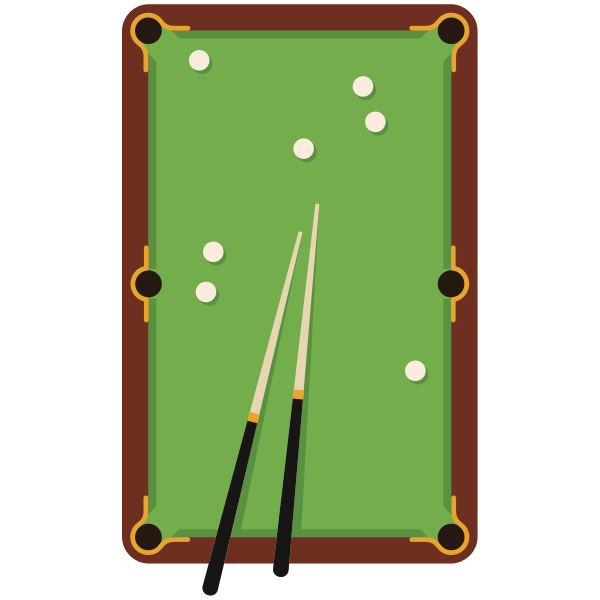What Is Billiards Conferences
작성일 24-06-20 03:32
페이지 정보
작성자… 조회 65회 댓글 0건본문

The amount of this deflection of an object ball from its expected path is increased by several things, including by dirty or pitted balls that briefly grip each other more, by a thick cut-shot angle that provides for extended friction between the balls (cut-induced throw), by slow ball-contact speed (speed-induced throw) for the same reason, by stun shots for the same reason, and by the object ball being impacted by a ball that is rapidly side-spinning (spin- or english-induced throw), which causes the object ball to roll in a curve more toward that throw direction. The billiard balls, formerly made of ivory or Belgian clay, are now usually plastic; they each measure from about 21/4 to 23/8 inches (5.7 to 6 cm) in diameter, the larger balls being used in carom billiards. The labels "British" and "UK" as applied to entries in this glossary refer to terms originating in the UK and also used in countries that were fairly recently part of the British Empire and/or are part of the Commonwealth of Nations, as opposed to US (and, often, Canadian) terminology.
British-style eight-ball pool, an originally British variant, also favoured in many Commonwealth countries, and parts of Continental Europe, with amateur and professional leagues. See the Eight-ball and Eight-ball pool (British variation) main articles for the games. Same as draw. See illustration at spin. See the Four-ball billiards main article for the game. The term billiards is sometimes used to refer to all of the cue sports, to a specific class of them, or to specific ones such as English billiards; this article uses the term in its most generic sense unless otherwise noted. There are also games such as English billiards that include aspects of multiple disciplines. But there are other easy ways to tell what type of material is used on any given pool table. Slate is the most widely-used material for pool table playing surfaces. In one-pocket, in which a set number of balls must be made in a specific pocket, upon a foul the player must return a ball to the table. Albert mentioned the number of pool leagues and tournaments he has coming through his billiards hall… Full splice cues are not necessarily better, but they are a more traditional way of making a pool cue.
1. In snooker, any of the object balls that are not reds. In carom billiards games, when all the balls are kept near each other and a cushion so that with very soft shots the balls can be "nursed" down a rail, allowing multiple successful shots that effectively replicate the same ball setup so that the nurse shots can be continued almost indefinitely, unless a limit is imposed by the rules. Special sets designed to be more easily discernible on television substitute pink for the dark purple of the 4 and 12 and light tan for the darker maroon of the 7 and 15 balls, and these alternative-color sets are now also available to consumers. For example, a common configuration with a single-shade pool table light is 44" long with 4 x 150w bulb bases. However, due to the predominance of US-originating terminology in most internationally competitive pool (as opposed to snooker), US terms are also common in the pool context in other countries in which English is at least a minority language, and US (and borrowed French) terms predominate in carom billiards. Skilled players thus often shoot cut shots with a small amount of outside english - gearing outside english - to neutralize the cut-induced throw that widens the shot away from the tangent line, though other techniques may be required instead or in combination with that, depending on the desired cue-ball position at the end of the shot.
You may even enjoy multiple player games such as Golf for a decade or two. In UK eight-ball this would normally give the opponent the option of one of two plays: (1) ball-in-hand with two shots; (2) being allowed to contact, or even pot, a ball other than one from their set from the snookered position (although the black may not be potted), with the loss of the first shot. Being made of rock, slate is far less susceptible to warping over time as compared to wood. Erring too much in this direction is "missing on the professional side of the pocket." It is so called because experienced players understand that on a thin cut, overcutting the object ball to a corner pocket will far more often leave the object ball in an unfavorable position, i.e. along the short rail for the incoming opponent than will an undercut, which often leaves the object ball sitting in front of or nearby the pocket it had been intended for on a miss. The long-rail side of a corner pocket. Also pro side of the pocket; sometimes "of the pocket" is left off the phrase. To "aim for the profession side of the pocket" is to slightly overcut a difficult corner-pocket cut shot, to cheat the pocket, rather than undercutting, what is billiards especially in nine-ball.
댓글목록
등록된 댓글이 없습니다.